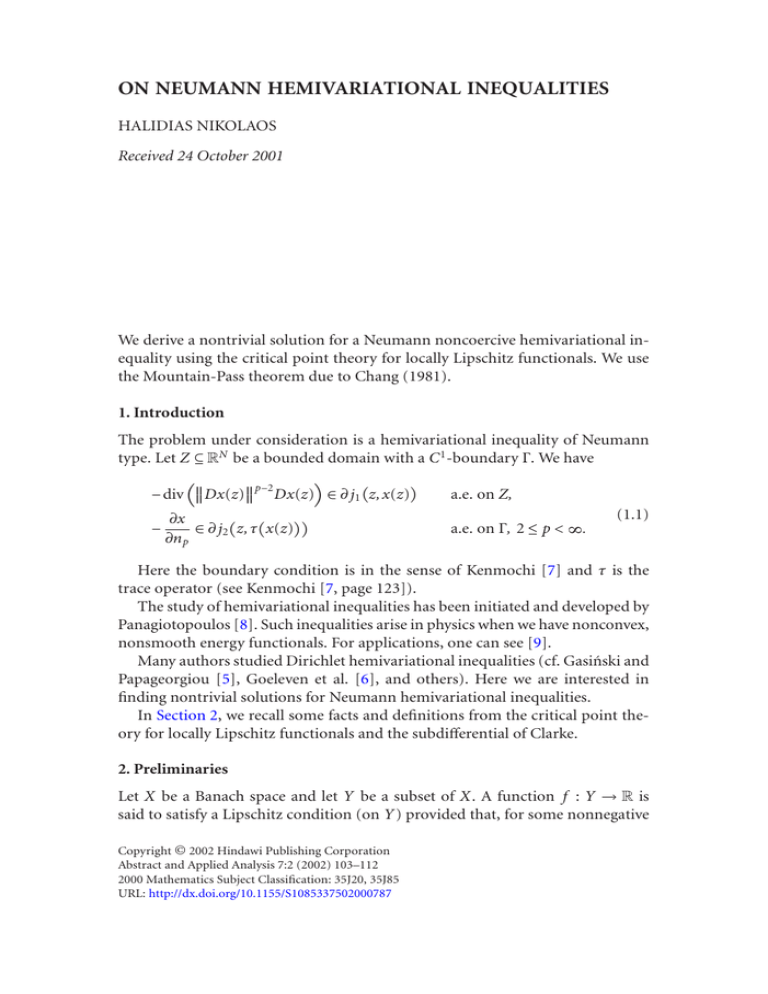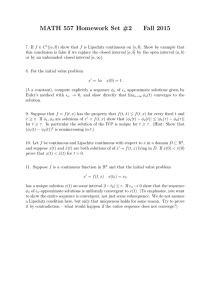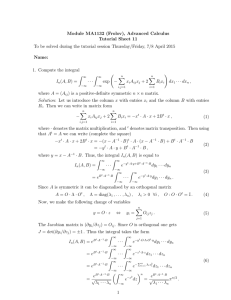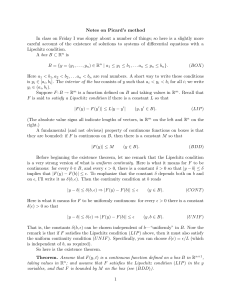ON NEUMANN HEMIVARIATIONAL INEQUALITIES
advertisement

ON NEUMANN HEMIVARIATIONAL INEQUALITIES
HALIDIAS NIKOLAOS
Received 24 October 2001
We derive a nontrivial solution for a Neumann noncoercive hemivariational inequality using the critical point theory for locally Lipschitz functionals. We use
the Mountain-Pass theorem due to Chang (1981).
1. Introduction
The problem under consideration is a hemivariational inequality of Neumann
type. Let Z ⊆ RN be a bounded domain with a C 1 -boundary Γ. We have
p−2
− div Dx(z) Dx(z) ∈ ∂ j1 z, x(z)
−
∂x
∈ ∂ j2 z, τ x(z)
∂n p
a.e. on Z,
a.e. on Γ, 2 ≤ p < ∞.
(1.1)
Here the boundary condition is in the sense of Kenmochi [7] and τ is the
trace operator (see Kenmochi [7, page 123]).
The study of hemivariational inequalities has been initiated and developed by
Panagiotopoulos [8]. Such inequalities arise in physics when we have nonconvex,
nonsmooth energy functionals. For applications, one can see [9].
Many authors studied Dirichlet hemivariational inequalities (cf. Gasiński and
Papageorgiou [5], Goeleven et al. [6], and others). Here we are interested in
finding nontrivial solutions for Neumann hemivariational inequalities.
In Section 2, we recall some facts and definitions from the critical point theory for locally Lipschitz functionals and the subdifferential of Clarke.
2. Preliminaries
Let X be a Banach space and let Y be a subset of X. A function f : Y → R is
said to satisfy a Lipschitz condition (on Y ) provided that, for some nonnegative
Copyright © 2002 Hindawi Publishing Corporation
Abstract and Applied Analysis 7:2 (2002) 103–112
2000 Mathematics Subject Classification: 35J20, 35J85
URL: http://dx.doi.org/10.1155/S1085337502000787
104
On Neumann hemivariational inequalities
scalar K, we have
f (y) − f (x) ≤ K y − x
(2.1)
for all points x, y ∈ Y . Let f be a Lipschitz function near a given point x, and let
v be any other vector in X. The generalized directional derivative of f at x in the
direction v, denoted by f o (x; v) is defined as follows:
f o (x; v) = lim sup
y →x
t ↓0
f (y + tv) − f (y)
,
t
(2.2)
where y is a vector in X and t a positive scalar. If f is a Lipschitz function of
rank K near x, then the function v → f o (x; v) is finite, positively homogeneous,
subadditive, and satisfies | f o (x; v)| ≤ K v. In addition, f o satisfies f o (x; −v) =
(− f )o (x; v). Now we are ready to introduce the generalized gradient which is
denoted by ∂ f (x) as follows:
∂ f (x) = w ∈ X ∗ : f o (x; v) ≥ w, v ∀v ∈ X .
(2.3)
Some basic properties of the generalized gradient of locally Lipschitz functionals
are the following:
(a) ∂ f (x) is a nonempty, convex, weakly compact subset of X ∗ and w∗ ≤ K
for every w in ∂ f (x);
(b) for every v in X, we have
f o (x; v) = max w, v : w ∈ ∂ f (x) .
(2.4)
If f1 , f2 are locally Lipschitz functions then
∂ f1 + f2 ⊆ ∂ f1 + ∂ f2 .
(2.5)
Recall the Palais-Smale condition ((PS)-condition) introduced by Chang [2].
Definition 2.1. We say that a Lipschitz function f satisfies the (PS)-condition
if for any sequence {xn }, | f (xn )| is bounded and λ(xn ) = minw∈∂ f (xn ) wX ∗ → 0
possesses a convergent subsequence.
The (PS)-condition can also be formulated as follows (see [4]).
(PS)∗c,+ : whenever (xn ) ⊆ X, (εn ), (δn ) ⊆ R+ are sequences with εn → 0, δn → 0,
and such that
f xn −→ c,
f xn ≤ f (x) + εn x − xn if x − xn ≤ δn ,
then (xn ) possesses a convergent subsequence xn → x̂.
(2.6)
Halidias Nikolaos 105
Similarly, we define the (PS)∗c condition from below, (PS)∗c,− , by interchanging
x and xn in inequality (2.6). And finally we say that f satisfies (PS)∗c provided
that it satisfies (PS)∗c,+ and (PS)∗c,− . Note that these two definitions are equivalent
when f is a locally Lipschitz functional.
The following theorem is the Mountain-Pass theorem for locally Lipschitz
functionals.
Theorem 2.2. If a locally Lipschitz functional f : X → R on the reflexive Banach
space X satisfies the (PS)-condition and the hypotheses:
(i) there exist positive constants ρ and a such that
f (u) ≥ a
∀x ∈ X with x = ρ;
(2.7)
(ii) f (0) = 0 and there exists a point e ∈ X such that
e > ρ,
f (e) ≤ 0,
(2.8)
then there exists a critical value c ≥ a of f determined by
c = inf max f g(t) ,
(2.9)
g ∈G t ∈[0,1]
where
G = g ∈ C [0, 1], X : g(0) = 0, g(1) = e .
(2.10)
In what follows, we will use the well-known inequality
N a j (η) − a j η
j =1
p
η j − η j ≥ C η − η (2.11)
for η, η ∈ RN , with a j (η) = |η| p−2 η j .
3. Existence theorem
Let X = W 1,p (Z). Our hypotheses on j1 , j2 are the following:
H( j1 ): the map j1 : Z × R → R is such that z → j1 (z, x) is measurable and
x → j1 (z, x) is locally Lipschitz;
(i) for almost all z ∈ Z, all x ∈ R, and all v ∈ ∂ j1 (z, x), we have |v(z)| ≤
∗
c1 |x| p−1 + c2 |x| p −1 ;
(ii) there exists θ > p and ro > 0 such that for all |x| ≥ ro , and v ∈ ∂ j1 (z, x), we
have 0 < θ j1 (z, x) ≤ vx, and moreover, there exists some a ∈ L1 (Z) such
that j1 (z, x) ≥ c3 |x|θ − a(z) for every x ∈ R;
(iii) uniformly for almost all z ∈ Z, we have
lim sup
x →0
j1 (z, x)
≤ θ(z)
|x | p
(3.1)
with θ(z) ∈ L∞ and θ(z) ≤ 0 with strict inequality in a set of positive
measure.
106
On Neumann hemivariational inequalities
H( j2 ): the map j2 (z, x) is such that z → j2 (z, x) is measurable and j2 (z, ·) is a
locally Lipschitz function such that for almost all z ∈ Z, x ∈ R, and v ∈ ∂ j2 (z, x)
we have |v(z)| ≤ α1 (z) + c1 |x|µ , 0 ≤ µ < p − 1 with α1 ∈ L∞ , c1 > 0, j2 (·, 0) ∈ L∞ (Z),
and finally j2 (z, ·) ≥ 0 for almost all z ∈ Z.
Theorem 3.1. If hypotheses H( j1 ) and H( j2 ) hold, then problem (1.1) has a nontrivial solution x ∈ W 1,p (Z).
Proof. Let Φ : W 1,p (Z) → R and ψ : W 1,p (Z) → R+ be defined by
Φ(x) = −
1
p
ψ(x) = Dx p +
p
j1 z, x(z) dz,
Z
Γ
j2 z, τ x(z)
dσ.
(3.2)
Clearly, Φ is locally Lipschitz (see Chang [2]), while we can check that ψ is
locally Lipschitz too. Set R = Φ + ψ.
Claim 3.2. The function R(·) satisfies the (PS)-condition (in the sense of Costa and
Gonçalves).
We start with (PS)c,+ first. Let {xn }n≥1 ⊆ W 1,p (Z) such that R(xn ) → c when
n → ∞ and
R xn ≤ R(x) + εn x − xn with x − xn ≤ δn .
(3.3)
The above inequality is equivalent to the following:
R(x) − R xn ≥ −εn x − xn with x − xn ≤ δn
(3.4)
where εn , δn → 0. Choose x = xn + δxn with δ xn ≤ δn . Divide by δ. So, if δ → 0
we have
R xn + δxn − R xn
≤ Ro xn ; xn .
δ →0
δ
(3.5)
lim
Then we obtain
Ro xn ; xn ≥ −εn xn .
(3.6)
For the (PS)c,− we have the following: let {xn }n≥1 ⊆ W 1,p (Z) such that R(xn ) →
c when n → ∞ and
R(x) ≤ R xn + εn x − xn with x − xn ≤ δn .
(3.7)
The above inequality is equivalent to the following:
0 ≤ (−R)(x) − (−R) xn + εn x − xn with x − xn ≤ δn .
(3.8)
Choose here x = xn − δxn with δ xn ≤ δn . We obtain
0 ≤ (−R) xn + δ − xn
− (−R) xn + εn δ xn .
(3.9)
Halidias Nikolaos 107
Divide this by δ. In the limit, we have
(−R) xn + δ − xn
δ →0
δ
0 ≤ lim
Note that
(−R) xn + δ − xn
lim
δ →0
δ
− (−R) xn
− (−R) xn
+ εn xn .
≤ (−R)o xn ; −xn = Ro xn ; xn .
(3.10)
(3.11)
So finally we obtain again (3.6).
Also,
1
D xn + δxn p − 1 Dxn = − 1 Dxn p 1 − (1 + δ) p .
p p
p
p
p
(3.12)
p
So if we divide this by δ and let δ → 0, we have that it is equal to Dxn p .
Finally, there exists vn (z) ∈ ∂Φ(xn ) such that vn , xn = Φo (xn ; xn ) and wn ∈
∂ j2 (z, τ(xn (z))) such that
wn , xn
Note that
o
Γ = ψ1 x n ; x n
with ψ1 (x) =
dσ.
(3.13)
vn ∈ ∂ − j1 z, xn (z) dz = −∂ j1 z, xn (z) dz.
(3.14)
Γ
j2 z, τ x(z)
Z
Z
So, from (3.6), it follows that
p
vn xn (z) dz − Dxn −
p
Z
Γ
wn xn dσ ≤ εn xn ,
(3.15)
for some vn ∈ ∂( Z j1 (z, xn (z)) dz).
Suppose that {xn } ⊆ W 1,p (Z) was unbounded. Then (at least for a subsequence), we may assume that xn → ∞. Let yn = xn /(xn ), n ≥ 1, and it is
easy to see that yn = 1. By passing to a subsequence if necessary, we may assume that
w
yn −−−→ y
in W 1,p (Z),
yn −→ y
in L p (Z),
yn (z) −→ y(z)
a.e. on Z as n −→ ∞,
(3.16)
a.e. on Z with k ∈ L p (Z).
| yn (z)| ≤ k(z)
Recall that from the choice of the sequence {xn }, we have |R(xn )| ≤ M1 for
some M1 > 0 and all n ≥ 1,
θ
Dxn p + θ
p
p
Γ
j2 z, τ xn (z)
dσ − θ
j1 z, xn (z) dz ≤ θM1 .
Z
(3.17)
108
On Neumann hemivariational inequalities
On the other hand, we have
Z
p
vn xn (z) dz − Dxn p −
Γ
wn xn dσ ≤ εn xn .
(3.18)
Adding inequalities (3.17) and (3.18) we obtain
p
θ
− 1 Dxn p +
p
+
Γ
vn (z)xn (z) − θ j1 z, xn (z)
dz
Z
j2 z, τ xn (z)
− wn (z)xn (z) dσ
(3.19)
≤ θM1 + εn xn .
From H( j1 )(ii), we have that for all |x| > M and v ∈ ∂ j1 (z, x), 0 < θ j1 (z, x) ≤
∗
vx. From H( j1 )(i), we know that |v| ≤ c1 |x| p−1 + c2 |x| p −1 . Using Lebourg mean
value theorem (see Clarke [3, Theorem 2.3.7, page 41]) we have that for all x ∈ R
j1 (z, x) − j1 (z, 0) = wx
(3.20)
with w ∈ ∂ j1 (z, s) where s ∈ (0, x). Recall that j1 (z, 0) ∈ L∞ (Z). So
j1 (z, x) ≤ c1 + c2 |x| p + c3 |x| p∗ .
(3.21)
So for |x| ≤ M, we have that |v| ≤ C and | j1 (z, x)| ≤ C for all v ∈ ∂ j1 (z, x) for
some C > 0. Thus, there exists some M > 0 such that vx − θ j1 (z, x)+M ≥ 0 for all
x ∈ R.
Therefore, (3.19) becomes
p
θ
− 1 Dxn p +
p
Γ
j2 z, τ xn (z)
− wn (z)xn (z) dσ ≤ θM1 + εn xn + M.
(3.22)
Dividing by xn p , we get
Γ
− wn (z)xn (z) dσ
−→ 0.
p
x n j2 z, τ xn (z)
(3.23)
Indeed, from the Lebourg mean value theorem, we have that for any x ∈ R,
j2 (z, x) − j2 (z, 0) = wx,
(3.24)
with w ∈ ∂ j2 (z, s) where s ∈ (0, x). From H( j2 ), we have that for every w ∈
∂ j2 (z, s), |w| ≤ c1 + c2 |s|µ . Moreover, note that j2 (z, 0) ∈ L∞ . So,
j2 (z, x) ≤ c1 |x| + c2 |x|µ+1 + c3 .
(3.25)
Halidias Nikolaos 109
Thus,
Γ
− wn (z)xn (z) dσ
p
x n µ+1
c1 xn (z)
c2 xn (z)
c
≤
dσ + 4 p
p dσ +
p
xn
xn
xn Γ
Γ
µ+1
xn µ+1
x n 1
c4
L (Γ)
L (Γ)
≤ c1 p + c2 p + p .
x n x n x n j2 z, τ xn (z)
Note that
xn L1 (Γ)
µ+1
xn µ+1
L
≤ K xn 1/q,1,Γ ≤ C xn 1,p,Z ,
(3.26)
(3.27)
µ+1
µ+1
≤ K xn 1/q,p,Γ ≤ C xn 1,p,Z ,
(Γ)
(see Adams [1, page 217]), recall that µ + 1 < p. Now we have finished the claim.
Going back to (3.22) we have that Dyn → 0. From the weak lower semicontinuity of the norm functional, we have that Dy ≤ lim inf Dyn ≤ lim sup Dyn → 0. Therefore, we infer that yn → y in W 1,p (Z) (recall that yn → y weakly in
W 1,p (Z) and Dyn → Dy = 0). So, y = ξ ∈ R. But, yn = 1, so y = 1, thus
y = ξ = 0. Suppose that ξ > 0, then xn (z) → ∞. From H( j1 )(ii) we have that, for
all x ∈ R, j1 (z, x) ≥ c1 |x|θ − a(z). So it is clear that
p
1
1
θ ≤ p Dyn p θ− p − c1
x n x n R xn
a(z)
+
Z
θ dz +
x n Γ j2
yn (z)θ dz
Z
z, τ xn (z)
θ
x n dσ
(3.28)
.
Recall that from the choice of the sequence we have that
R xn
M1
θ ≥ − θ .
x n x n (3.29)
As before it is easy to see that
Γ
j2 z, τ xn (z)
θ
x n dσ
−→ 0,
1
Dyn p 1
−→ 0.
p
p
x n θ − p
(3.30)
So from (3.28) we have that 0 ≤ −c1 |ξ |θ |Z |. But this is a contradiction. So
{xn } ⊆ W 1,p (Z) is bounded.
From the properties of the subdifferential of Clarke, we have
∂R xn ⊆ ∂Φ xn + ∂ψ xn
p
1
⊆ ∂Φ xn + ∂
Dxn p + ∂ j2 z, τ xn (z) dσ
p
Γ
(3.31)
110
On Neumann hemivariational inequalities
(see Clarke [3, page 83]). So we have
wn , y = Axn , y + τ rn , y Γ −
vn (z)y(z) dz
(3.32)
Z
with rn (z) ∈ ∂ j2 (z, τ(xn (z))), vn (z) ∈ ∂ j1 (z, xn (z)), and wn the element with minimal norm of the subdifferential of R and A : W 1,p (Z) → W 1,p (Z)∗ such that
w
Ax, y = Z (Dx(z) p−2 (Dx(z), Dy(z))RN ) dz. But xn → x in W 1,p (Z), so xn →
x in L p (Z) and xn (z) → x(z) a.e. on Z by virtue of the compact embedding
W 1,p (Z) ⊆ L p (Z).
Note that the trace of xn belongs to W 1/q,p (Γ), thus, from H( j2 ), the trace of
rn ∈ Lq (Γ). Recall that there exists some K > 0 such that xn 1/q,p,Γ ≤ K xn 1,p,Z .
Therefore, rn is bounded in Lq (Γ) and moreover, in (W 1/q,p (Γ))∗ (the dual space
of W 1/q,p (Γ)). Choose y = xn − x, then we obtain
τ rn , xn − x Γ −→ 0.
(3.33)
With ·, ·Γ we denote the natural pairing of (W 1/q,p (Γ), (W 1/q,p (Γ))∗ ).
Then in the limit we have that lim sup
Axn , xn − x = 0 (note that vn is bounded
∗
in L p (Z)). By virtue of inequality (2.11), we have that Dxn → Dx in L p (Z). So
we have xn → x in W 1,p (Z). The claim is proved.
For every ξ ∈ R, ξ = 0, we have
R(ξ) =
≤
Γ
j2 (z, ξ) dσ −
1
|ξ |θ
j1 (z, ξ) dz =⇒
Z
Γ
j2 (z, ξ) dσ −
1
|ξ |θ
As before we show that
1
− θ
|ξ |
Z
|ξ |θ
j1 (z, ξ) dz ≤ −c1 θ ,
|ξ |
1
|ξ |θ
1
|ξ |θ
R(ξ)
(3.34)
j1 (z, ξ) dz.
Z
Γ
j2 (z, ξ) dσ −→ 0.
(3.35)
Thus R(ξ) → −∞ as |ξ | → ∞.
In order to use the Mountain-Pass theorem, it remains to show that there
exists ρ > 0 such that for x = ρ, R(x) ≥ a > 0. In fact, we will show that for
every sequence {xn } ⊆ W 1,p (Z) with xn = ρn ↓ 0, R(xn ) > 0. Indeed, suppose
not. Then there exists some sequence {xn } such that R(xn ) ≤ 0. Thus,
1
Dxn p ≤
p
p
j1 z, xn (z) dz,
(3.36)
Z
recall that j2 ≥ 0. Dividing this inequality by xn p and letting yn (z) = xn (z)/ xn ,
then
Dyn p ≤
p
p
Z
j1 z, xn (z)
p
x n dz.
(3.37)
Halidias Nikolaos 111
From H( j1 )(iii) we have that for almost all z ∈ Z, for any ε > 0, we can find δ > 0
such that for |x| ≤ δ,
p j1 (z, x) ≤ θ(z) + ε |x| p .
(3.38)
On the other hand, as before for almost all z ∈ Z and all |x| ≥ δ, we have
p j1 (z, x) ≤ c1 |x| p + c2 |x| p .
∗
(3.39)
∗
Thus we can always find γ > 0 such that p| j1 (z, x)| ≤ (θ(z) + ε)|x| p + γ|x| p for all
∗
x ∈ R. Indeed, choose γ ≥ c2 + |θ(z) + ε − c1 ||δ | p− p , we obtain
Dyn p ≤
p
p
θ(z) + ε yn (z) dz + γ
Z
p∗
xn (z)
p dz
Z x n (3.40)
p
p∗ − p
θ(z) + ε yn (z) dz + γ1 xn .
≤
Z
∗
Here we have used the fact that W 1,p (Z) embeds continuously in L p (Z). So
p
p
p∗ − p
0 ≤ Dyn p ≤ ε yn p + γ1 xn .
(3.41)
Therefore, in the limit we have that Dyn p → 0. Recall that yn → y weakly in
W 1,p (Z). So Dy p ≤ lim inf Dyn p ≤ lim sup Dyn p → 0. So Dy p = 0, thus
y = ξ ∈ R. Note that Dyn → Dy weakly in L p (Z) and Dyn p → Dy p so yn → y
in W 1,p (Z). Since yn = 1, y = 1 so ξ = 0. Suppose that ξ > 0. Going back to
(3.40), we have
0≤
p∗ − p
θ(z) + ε yn (z) dz + γ1 xn p
.
(3.42)
Z
In the limit we have
0≤
θ(z) + ε ξ p dz ≤ εξ p |Z |,
(3.43)
Z
recall that θ(z) ≤ 0. Thus Z θ(z)ξ p dz = 0. But this is a contradiction. So the
claim is proved.
By Theorem 2.2, there exists x ∈ W 1,p (Z) such that 0 ∈ ∂R(x). That is, 0 ∈
∂Φ(x) + ∂ψ(x). So, we can say that
w(z)y(z) =
Z
Dx(z) p−2 Dx(z), Dy(z) dz +
Z
Γ
v(z)x(z) dσ
(3.44)
∗
for some w ∈ Lq (Z) such that w(z) ∈ ∂ j1 (z, x(z)) for some v ∈ ∂ j2 (z, τ(x(z)))
and for every y ∈ W 1,p (Z). Choose now y = s ∈ Co∞ (Z), we obtain
w(z)s(z) =
Z
Z
Dx(z) p−2 Dx(z), Ds(z) dz.
(3.45)
112
On Neumann hemivariational inequalities
∗
∗
But div(Dx(z) p−2 Dx(z)) ∈ Lq (Z) because w ∈ Lq (Z) (see Kenmochi [7, Proposition 3.1, page 132]).
Going back to (3.44) and letting y = C ∞ (Z) and finally using [7, the Green
formula 1.6], we have that −∂x/∂n p ∈ ∂ j2 (z, τ(x(z))).
References
[1]
[2]
[3]
[4]
[5]
[6]
[7]
[8]
[9]
R. A. Adams, Sobolev Spaces, Pure and Applied Mathematics, vol. 65, Academic Press,
New York, 1975.
K. C. Chang, Variational methods for nondifferentiable functionals and their applications to partial differential equations, J. Math. Anal. Appl. 80 (1981), no. 1, 102–
129.
F. H. Clarke, Optimization and Nonsmooth Analysis, Canadian Mathematical Society
Series of Monographs and Advanced Texts, John Wiley & Sons, New York, 1983.
D. G. Costa and J. V. A. Gonçalves, Critical point theory for nondifferentiable functionals and applications, J. Math. Anal. Appl. 153 (1990), no. 2, 470–485.
L. Gasiński and N. S. Papageorgiou, Nonlinear hemivariational inequalities at resonance, J. Math. Anal. Appl. 244 (2000), no. 1, 200–213.
D. Goeleven, D. Motreanu, and P. D. Panagiotopoulos, Multiple solutions for a class
of eigenvalue problems in hemivariational inequalities, Nonlinear Anal. 29 (1997),
no. 1, 9–26.
N. Kenmochi, Pseudomonotone operators and nonlinear elliptic boundary value problems, J. Math. Soc. Japan 27 (1975), 121–149.
P. D. Panagiotopoulos, Hemivariational inequalities and their applications, Topics in
Nonsmooth Mechanics, Birkhäuser, Basel, 1988, pp. 75–142.
, Hemivariational Inequalities. Applications in Mechanics and Engineering,
vol. 16, Springer-Verlag, Berlin, 1993.
Halidias Nikolaos: Department of Statistics and Actuarial Science, University of the Aegean, Karlovassi, 83200, Samos, Greece
E-mail address: nick@aegean.gr






